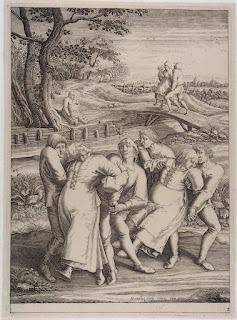The dancing plague 1518–world history and facts
The dancing plague 1518–world history and facts
The dancing plague kicked off with a woman named Lady Troffea(or Frau Troffea) dancing wildly in a busy street of Strasbourg one afternoon in July 1518..
Onlookers thought she was in high spirits, so they cheered and clapped for her.
But when the dance continued for 6 days straight, it became clear that high spirits is not the reason for her dance-a-thon.
Within a week, 34 locals joined the dance frenzy. By August 1518, at least 400 were twisting, twirling and gyrating in the streets of Strasbourg, that looked like the venue of modern day music festival. The city council was advised by physicians to let the afflicted dance away the “fever”. 15 people were falling dead daily from the sheer exhaustion of dancing non-stop at the height of the epidemic.
Reasons Given By Modern Experts
Ergot Poisoning: Ergot is a fungus that grows on rye and related plants. It has psychoactive chemical products which can cause severe hallucinations and spasms. Rye bread was a common food item in those times. There were suggestions that ergot poisoning could be the reason for the plague dance of 1518.
Mass Hysteria: Many experts argue the dancing plague to be a case of mass hysteria. Mass hysteria means collections of populations exhibiting the same behavior, often bizarre, for unknown or unexplainable reasons.
Ivan Crozier, a lecturer in the Science Studies Unit at Edinburgh University, supports this theory. Lady Troffea(the first dancer), he believes, was a victim of ergot poisoning. Her dance frenzy had an effect of mass hysteria, and others subsequently joined in.
Mass hysteria outbreaks occur in populations with elevated levels of psychological stress.
John Waller theorizes that disease, starvation, and the superstitious beliefs of the people of Strasbourg could’ve induced a stress-related psychosis which became the Dancing Plague of 1518.
Could It Re-Emerge Today?
The most widely accepted cause of the Dancing Plague was mass hysteria.
Mass hysteria occurs in populations that are under psychological stress and tend to be superstitious.
We have witnessed cases of mass hysteria in the 21st century as well. Bizarre and unexplainable behavior continues to show up in certain parts of the world where the conditions are perfect for a mass hysteria outbreak.
But its very unlikely that this particular “plague” would re-emerge today. Medical science has progressed, mental health awareness has improved and nobody will let you dance in the streets like this in today’s world. In 1518, physicians actually advised that the people dancing should be allowed to dance. No physician will give such advice today.
In my opinion, viral behavior motivated by means of social media is also a case of mass hysteria, for eg. the kiki challenge. But we can explain it, so its not classified as mass hysteria.


.jpg)

.jpeg)






Comments
Post a Comment